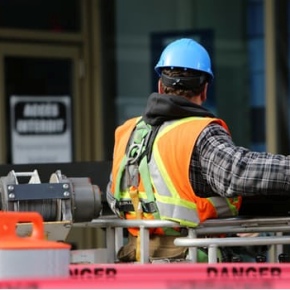
GUEST ARTICLE: Falls from height – are you legally responsible?
In a piece by Adrian Rooney, Chair of the NASC Health and Safety Committee and Managing Director of Midland Scaffolding Services, the issue of who is responsible for when a contractor is injured after falling from a scaffold is discussed…
“MOST people answering this question correctly apportion liability to the contractor’s employer and the scaffolding contractor, however many respondents completely overlook another party that could be held to blame; the principal contractor or developer.
Worryingly, many principal contractors and developers are themselves unaware of their legal responsibilities under Work at Height Regulations 2005 – and the financial penalties they face for breaching this legislation.
In April 2018, a principal contractor received an eight-month sentence suspended for two years and was ordered to pay £5,000 compensation and £2,000 in costs after a self-employed worker fell from height and suffered life threatening injuries.
Leeds Crown Court heard how the operative fell approximately eight metres on to a paved floor, resulting in a traumatic brain injury, bruising, and damage to his left arm.
An investigation by the Health and Safety Executive (HSE) found that scaffolding erected on the site did not extend fully across the intended area of works and did not provide a protective area along the ledge where the operative was working. The principal contractor failed to ensure suitable and sufficient measures were in place to prevent persons falling a distance liable to cause personal injury.
This case demonstrates the need for developers and principal contractors using scaffolds on their projects to be fully responsible for managing this equipment. HSE regulations state that they should check that anyone they appoint has the skills, knowledge, experience and, where relevant, the organisational capability to carry out their work safely and without risk to health.
But what does this mean in practice and how do those organisations protect themselves from the possibility of prosecution and potentially severe financial penalties?
The NASC would remind everyone with responsibility that scaffold inspections are undertaken weekly as required by the Work at Height Regulations 2005 and that all tradesman using the scaffolds are fully aware of how to work on the scaffold safely and have received appropriate training.
We also strongly recommend that their procurement process is robust. They should be able to demonstrate that the scaffolding contractor they appoint has the necessary competence and experience to erect and dismantle scaffolding safely with skilled operatives and can evidence that they are health and safety compliant.
This can easily be achieved by simply ensuring they utilise the services of an NASC full contracting member. To gain, and then retain, NASC membership, the scaffolding contractor must prove they are experienced and meet all current health and safety legislation and their operatives are highly trained with an emphasis on directly employed operatives, as well as meeting additional stringent membership criteria.
By adopting an NASC only scaffolding procurement policy, companies can go a long way to protecting themselves against the likelihood of prosecutions and associated financial penalties or custodial terms under the recent Health and Safety Sentencing Guidelines.
We believe that greater awareness of the potential legal and financial risks principal contractors and developers currently expose themselves to will result in an increased appreciation of the peace of mind value of using NASC only.
So, remember, when it comes to procuring safe and compliant scaffolding that won’t leave you liable in the event of a fall from height – it has to be NASC.”
Latest news

26th July 2024
Enfield Speciality Doors completes world-class project for Atlas Copco HQ
A rundown office and warehouse building completely transformed into a modern headquarters for Atlas Copco has been fitted with more than 120 internal fire doors from Enfield Speciality Doors.
Posted in Access Control & Door Entry Systems, Articles, Building Industry News, Building Products & Structures, Building Systems, Case Studies, Doors, Interior Design & Construction, Interiors, Posts, Restoration & Refurbishment, Retrofit & Renovation, Security and Fire Protection, Sustainability & Energy Efficiency, Timber Buildings and Timber Products, Wooden products
26th July 2024
Abloy UK launches new white paper
Abloy UK, a leading provider of security and access control solutions, has launched a new white paper.
Posted in Access Control & Door Entry Systems, Architectural Ironmongery, Articles, Building Industry News, Building Products & Structures, Building Services, Doors, Facility Management & Building Services, Health & Safety, Information Technology, Innovations & New Products, Publications, Research & Materials Testing, Security and Fire Protection
26th July 2024
MCRMA Member Profile: David Roy, Director of Roofconsult
David Roy of MCRMA member company Roofconsult has more than 50 years’ experience to draw upon working in the building envelope sector and a unique perspective on how it has changed in that time.
Posted in Articles, BIM, Infrastructure & CAD Software, Building Associations & Institutes, Building Industry News, Building Products & Structures, Building Services, Building Systems, Cladding, Information Technology, Restoration & Refurbishment, Retrofit & Renovation, Roofs, Walls
26th July 2024
Strand: Enhancing Door Functionality and Safety
Craig Fox, Sales Director for Strand Hardware, outlines how door industry professionals might apply door limiting stays…
Posted in Architectural Ironmongery, Articles, Building Industry News, Building Products & Structures, Building Services, Doors, Facility Management & Building Services, Health & Safety, Restoration & Refurbishment, Retrofit & Renovation
 Sign up:
Sign up: